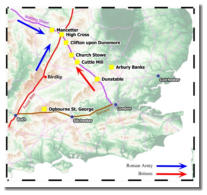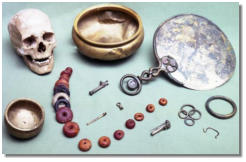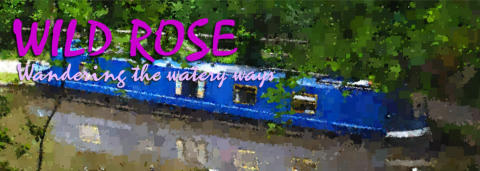

Mancetta or “Whatever happened to Boudicca”
Mancetter is a variant form of an old Celtic name Manduessedum, and is considered to be the most likely location of the last battle between an alliance of indigenous British peoples led by the Queen of the Iceni, the fabled Boudicca and a Roman force led by the less fabled Gaius Suetonius Paulinus . The Roman army was heavily outnumbered by the Britons but won through by superior military tactics. The whole thing kicked off when Boudicca’s husband died and the Romans annexed his kingdom, abusing her and her two daughters. The Roman historian, Cassius Dio, writing 150 years after the events, described her...“She was huge of frame, terrifying of aspect and with a harsh voice, a great mass of bright red hair fell to her knees.” In an act of revenge against Rome and consistent with her “aspect” Boudicca led a revolt and sacked the towns of London, Colchester and St Albans. Which leads us to the final battle in a place consistent with an army of Britons attacking from the area of London toward the Roman forces concentrating from the direction of Cornwall and Wales. Whether the Roman forces approached along the Fosse Way or Watling Street (or perhaps both) they had to encounter the Britons along Watling Street. The result is disaster for the Britons. Boudicca and probably her daughters die either from illness or suicide. I think the balance of probability is suicide for they knew that capture meant ritual torture and execution in the Roman arena. Similarly the Britons would have wanted to hide the bodies which would have been trophies for the victors. The site of the burials has long been a matter of intense interest for historians, and the roman writers Tacitus and Cassius Dio give no hint as to where that may be. However… In 1879 a couple of men digging stone for road repair on the scarp overlooking the Vale of Gloucester in Birdlip discovered the graves of three skeletons and some very fancy gravegoods. Further investigation indicated that the central skeleton, at least, was that of a high ranking woman. The theory is, of course, that these remains are Boudicca and her two daughters. The gravegoods include an ornate handheld mirror described as one of the finest items of Celtic art to survive today, two fine bronze bowls (one of which was placed over the woman’s face), bracelets, the stylized face of a bird in a silver gilt brooch, a pair of tweezers, five cast bronze rings, a bronze knife handle shaped like the head of a bull, an amber necklace, and an exotic stone that possibly originated in China. So there you go, sounds like the sort of light luggage that a defeated Queen might have about her person for the next life. But of course this is all conjecture...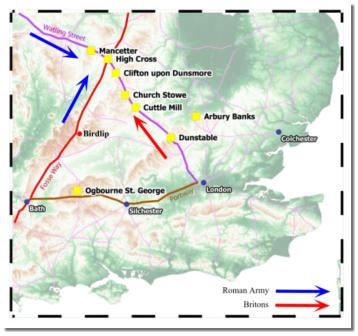
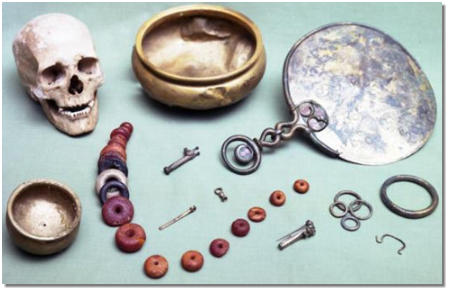


Mancetta or “Whatever happened to
Boudicca”
Mancetter is a variant form of an old Celtic name Manduessedum, and is considered to be the most likely location of the last battle between an alliance of indigenous British peoples led by the Queen of the Iceni, the fabled Boudicca and a Roman force led by the less fabled Gaius Suetonius Paulinus . The Roman army was heavily outnumbered by the Britons but won through by superior military tactics. The whole thing kicked off when Boudicca’s husband died and the Romans annexed his kingdom, abusing her and her two daughters. The Roman historian, Cassius Dio, writing 150 years after the events, described her...“She was huge of frame, terrifying of aspect and with a harsh voice, a great mass of bright red hair fell to her knees.” In an act of revenge against Rome and consistent with her “aspect” Boudicca led a revolt and sacked the towns of London, Colchester and St Albans. Which leads us to the final battle in a place consistent with an army of Britons attacking from the area of London toward the Roman forces concentrating from the direction of Cornwall and Wales. Whether the Roman forces approached along the Fosse Way or Watling Street (or perhaps both) they had to encounter the Britons along Watling Street. The result is disaster for the Britons. Boudicca and probably her daughters die either from illness or suicide. I think the balance of probability is suicide for they knew that capture meant ritual torture and execution in the Roman arena. Similarly the Britons would have wanted to hide the bodies which would have been trophies for the victors. The site of the burials has long been a matter of intense interest for historians, and the roman writers Tacitus and Cassius Dio give no hint as to where that may be. However… In 1879 a couple of men digging stone for road repair on the scarp overlooking the Vale of Gloucester in Birdlip discovered the graves of three skeletons and some very fancy gravegoods. Further investigation indicated that the central skeleton, at least, was that of a high ranking woman. The theory is, of course, that these remains are Boudicca and her two daughters. The gravegoods include an ornate handheld mirror described as one of the finest items of Celtic art to survive today, two fine bronze bowls (one of which was placed over the woman’s face), bracelets, the stylized face of a bird in a silver gilt brooch, a pair of tweezers, five cast bronze rings, a bronze knife handle shaped like the head of a bull, an amber necklace, and an exotic stone that possibly originated in China. So there you go, sounds like the sort of light luggage that a defeated Queen might have about her person for the next life. But of course this is all conjecture...